
It’s been almost a decade since the inception of Bitcoin, a technology created by the infamous and anonymous Satoshi Nakamoto. Over the years, many people have been hunting for Bitcoin’s inventor and Satoshi sightings have increased a great deal since 2016. During the course of 2018 there were numerous so-called Satoshi sightings and a couple of individuals who claimed to be the mysterious creator himself.
Also Read: New Information Heightens Satoshi Nakamoto Mystery
Satoshis Everywhere
2018 was a crazy year for cryptocurrency enthusiasts and a prolific one for all the loons who claimed to be Satoshi Nakamoto. A bunch of individuals came out of the woodwork this year to tell the world they created Bitcoin, and one of them even published the first chapter of a purported Satoshi Nakamoto autobiography. Then there were a few odd Satoshi-related sightings like the ‘21e8’ bitcoin hash, which actually led people to believe Satoshi was an alien time traveler with the ability to utilize superior quantum computation. Each and every story and self-proclaimed Satoshi failed to sway the crypto community in 2018, but nevertheless, the discussions revolving around Bitcoin’s creator remained as fun as ever.
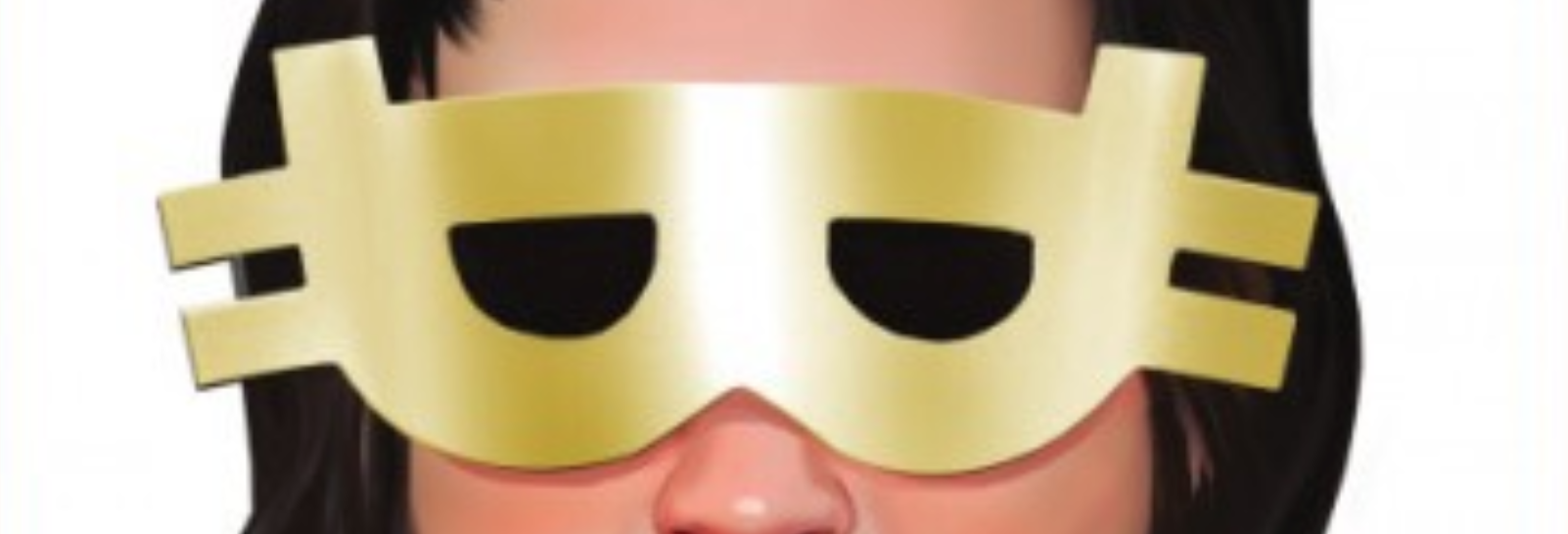
Satoshi’s Tell-All Book
This summer, bitcoiners found out that Satoshi Nakamoto was allegedly writing an autobiography. Back in June, Bloomberg columnist Matthew Leising led a few gullible people to believe that Satoshi was possibly writing his memoirs in order to publish a tell-all. A website called Nakamotofamilyfoundation.org, which has since been deleted, was a 21-page PDF of the first chapter. The website’s creators even added a cryptogram puzzle so curious readers could find some more ‘clues’ after solving.
“Announcing the first excerpt to a literary work consisting of two parts and the excerpt is provided — I wanted to include it as a brief glimpse of history — Even for those that can’t read the full book, I wanted to make this available to everyone,” explained the Nakamotofamilyfoundation.org website.
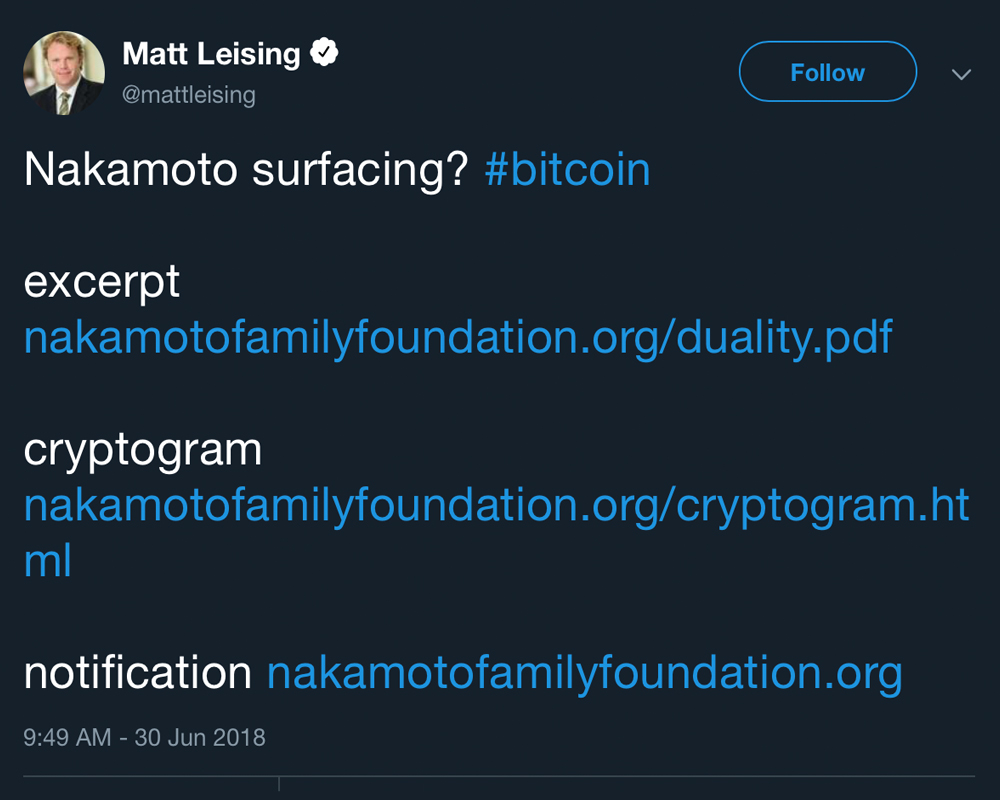
It only took a few hours for armchair sleuths to debunk the exposé’s 21-page manuscript. The document was also assessed with stylometrics and failed to match up with Satoshi’s previous writings. Naturally, the Satoshi Nakamoto autobiography was forgotten about very quickly, the website was deleted, and the second published excerpt never materialized.
Stylometric Research Said Gavin Andresen Was Satoshi

In another case involving stylometry this year, a study was done by the nonprofit organization Zy Crypto, based in England. Stylometry is a scientific method that studies the linguistic style of typed text and handwriting in order to find similarities in prior writings. According to Zy Crypto’s research, the true identity of Satoshi Nakamoto is likely the well-known Bitcoin developer Gavin Andresen. However, after Zy Crypto’s study was published, Andresen spoke out on Twitter and told his followers he had lost a lot of faith in the science of stylometry, stating “My opinion of the accuracy of Stylometry has dropped significantly after reading this.”
The Owner of the Bitcoin Cash Trademark
Another Satoshi sighting took place in June when it was discovered that a resident from Hawaii had filed trademark requests for the name Bitcoin Cash and was also squatting on numerous BCH and Satoshi-based web domains. Two trademark filings for the phrase ‘Bitcoin Cash’ were registered with the United States Patent and Trademark Office (USPTO) in 2018 and the owner of the trademarks also claimed to be Satoshi Nakamoto.
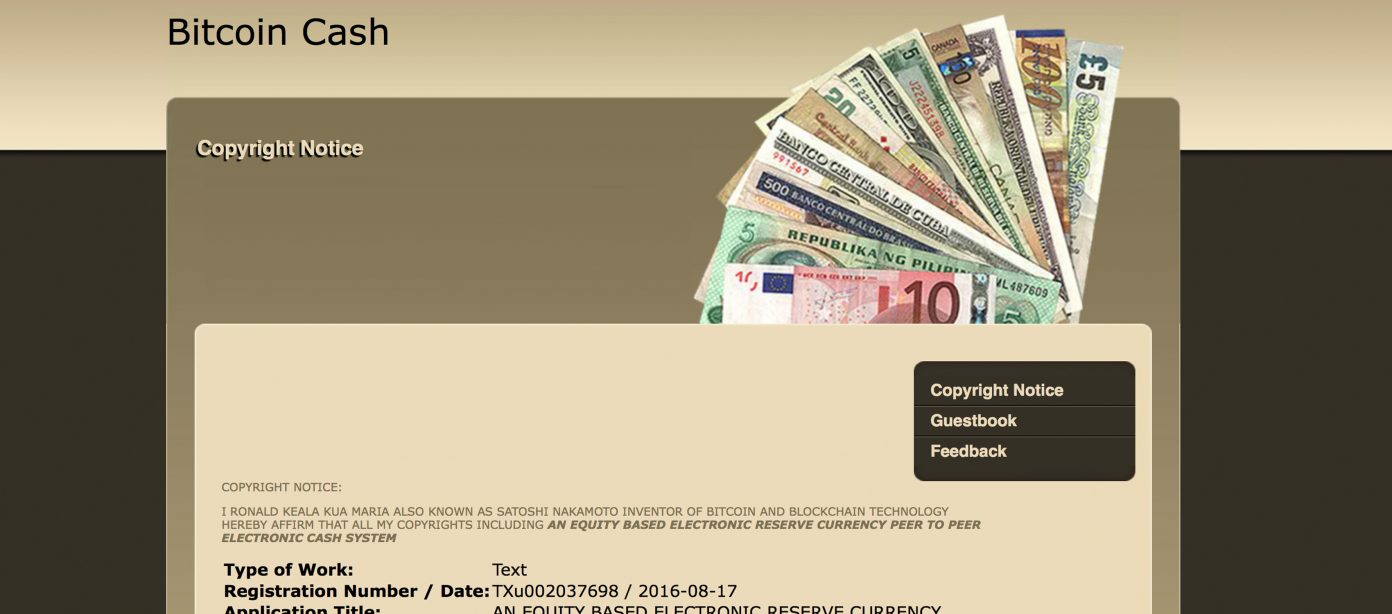
Looking further down the rabbit hole, the website domains and trademarks led to a person named Ronald Keala Kua Maria. According to reports in 2001, Kua Maria was allegedly involved with fraud and grifting accusations. Kua Maria’s website describes why he patented the phrase ‘Bitcoin Cash’ while also detailing that he is the creator of Bitcoin.
“I am the real one and only Satoshi Nakamoto — I own all the private keys, blockchains, altcoins and bitcoins under copyright law. In the event of my death, incapacitation, coma, kidnapping, detainment and or incarceration all of my copyrighted works and all related works shall no longer be used by anyone anywhere for any reason at any time subject to change without any notice at any time by Ronald Keala Kua Maria only,” explained the website Satoshinakamoto.ws.
A So-Called Block 9 Signature
On Nov. 16, cryptocurrency enthusiasts noticed a message that stemmed from the Bitcoin blockchain at height 9. To some people, the message appeared to be a valid signature from Satoshi’s key in block 9, but the story was also quickly debunked. This particular stunt also involved a Satoshi Twitter handle (now deleted) which tried to spread the disinformation that the signature should be taken seriously.
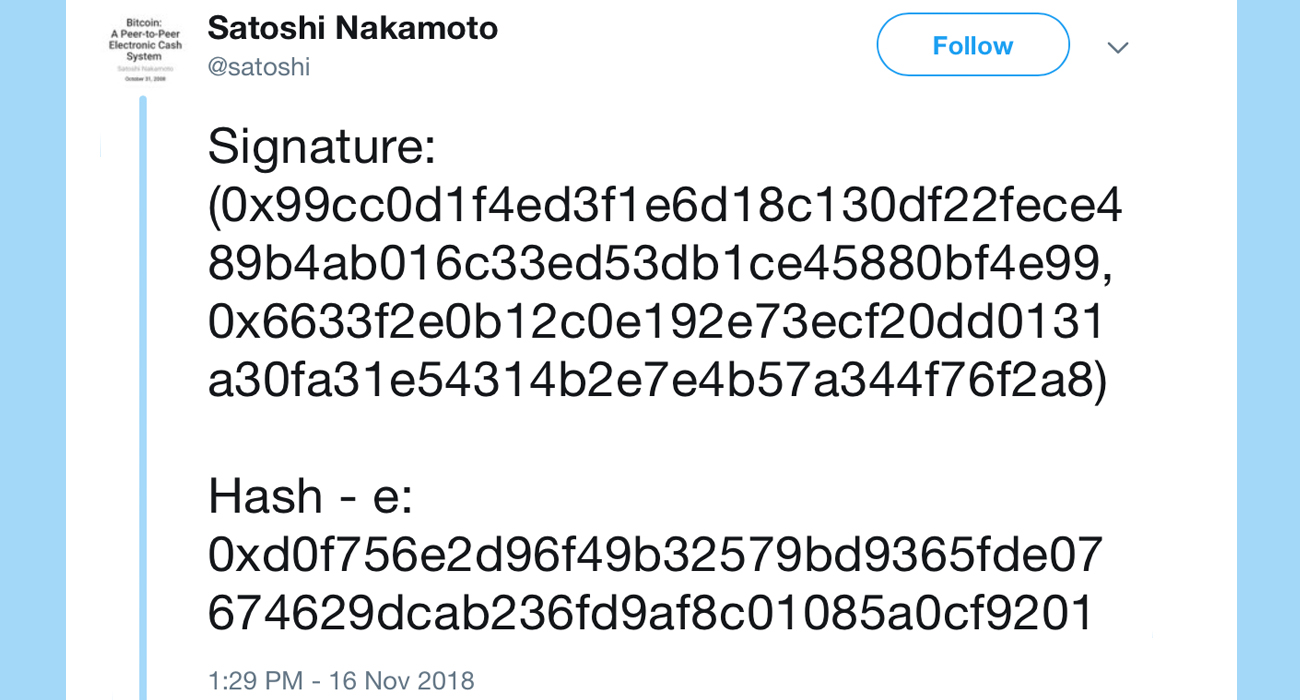
The message tied to block 9 alleged that there are significant problems with the Segregated Witness protocol, but the so-called Satoshi would not reveal the issues until 2019. Then, two well-known blockchain developers Christopher Jeffrey (Purse CTO) and Gregory Maxwell showed the crypto community how the signature was a ridiculous attempt to push an agenda. Maxwell illustrated how easy it was to accomplish this parlor trick and signed a message from the Genesis block. “Are you going to start claiming that I’m the creator of Bitcoin now?” Maxwell asked.
Satoshi Supposedly Says One Word on the P2P Foundation Forum
Another alleged Satoshi message this year came on Nov. 29 when the Satoshi Nakamoto handle registered to the P2P Foundation forum wrote one word. That day the registered user posted the word “nour” which got the internet’s armchair detectives all riled up. The word has several meanings and could translate to an “affectionate and caring person” or it could mean the Arabic version of the word “نور” which is defined as “light.” Aside from Satoshi’s one-word message, the handle of P2P Foundation Satoshi’s last activity was becoming friends with a mysterious person named Wagner Tamanaha back in 2016.
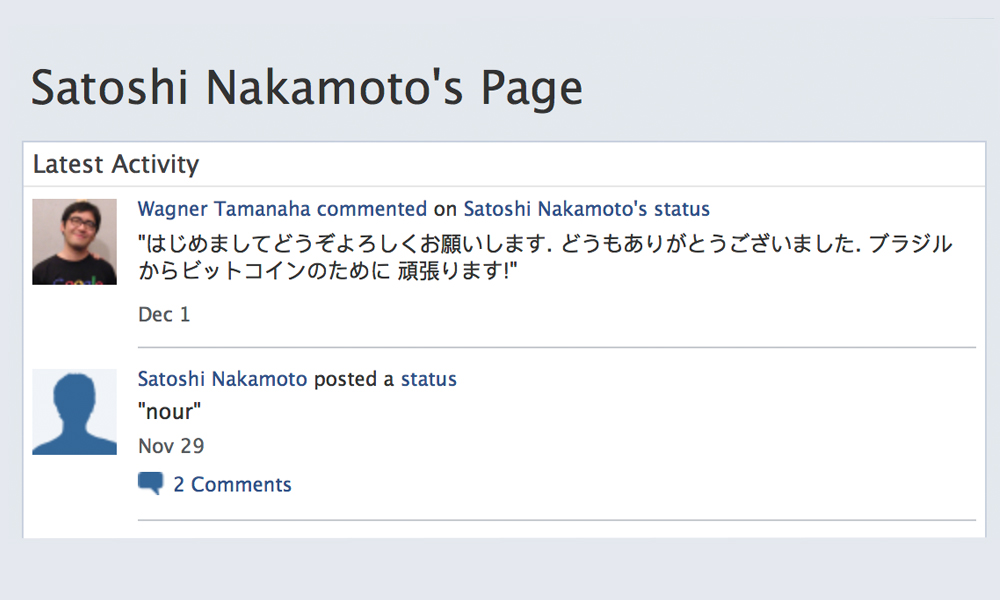
Interestingly, Tamanaha responded to Satoshi’s “nour” message on Dec. 1 in Japanese and stated, “Nice to meet you, thank you very much — Thanks for Bitcoin from Brazil.” The message, which was difficult to translate, was also forgotten quickly, with many people believing that some of Satoshi’s login credentials like his GMX email have been compromised. According to Theymos in 2014, the GMX email sent him a message which made him almost certain that the email account was “compromised.”
The Time Traveling Alien Theory
When the mining pool Btc.top mined block number 528249 on the BTC chain on June 19 with the block hash: 00000000000000000021e800 it drove the internet crazy. The message was first discovered by Mark Wilcox who tweeted the unusual hash to his followers and the message immediately went viral.
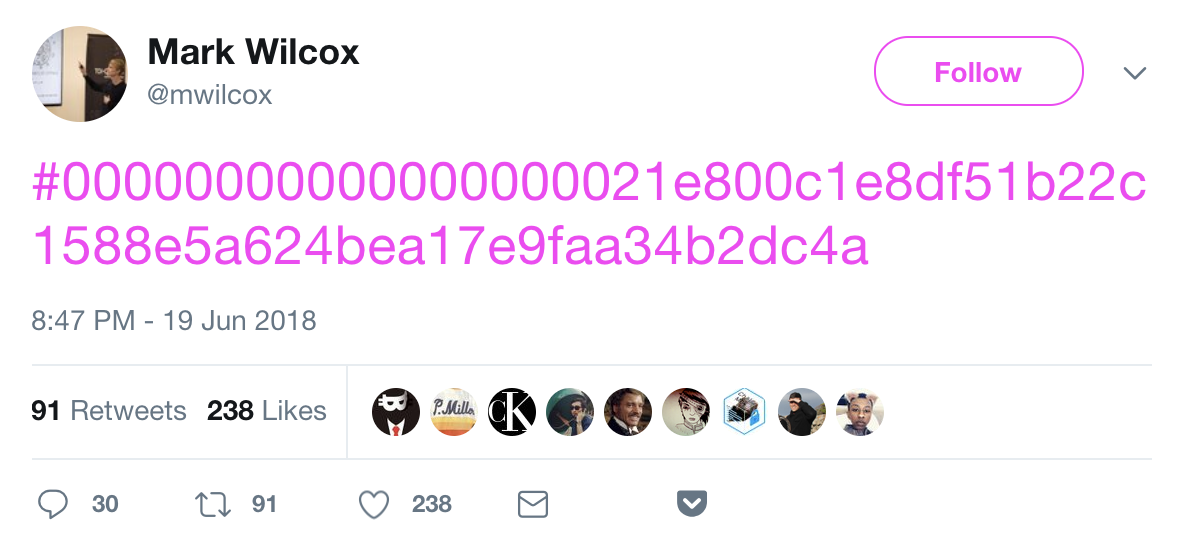
There were many significant theories tied to the block hash, one of them being that Satoshi could have been a time-traveling alien with extraordinary quantum computing abilities. Twitter personalities discussed how the hash pattern may be tied to ‘E8’, the Theory of Everything, otherwise known as the Unified Field Theory. After intense discussions concerning the meaning of the hash, one Twitter personality stated:
So my mind is melting — Satoshi may be artificial intelligence. And/or time traveling. Maybe quantum computing now exists — Esoteric and metaphysical meaning has found its way to crypto.
The ‘21e800’ message in block 528249 was again forgotten as fast as it came, but remains one of the wildest Satoshi theories of all time.
A Man Called Scronty

Phil Wilson, otherwise known as ‘Scronty,’ claimed to be part of the Satoshi Nakamoto group theory with David Kleiman and Craig Wright. Scronty did a bunch of interviews with news publications this year, including a discussion with news.Bitcoin.com. The huge problem with Scronty’s story is that he has absolutely no evidence that can prove he is legitimately the creator of Bitcoin. But that didn’t stop him from writing his “Bitcoin Origins” story which offers a very long-winded description on how he and two other guys developed the technology. Crypto enthusiasts do not buy Scronty’s story, mostly because he doesn’t have any proof. Martti Malmi, an early developer and one of the older owners of Bitcoin.org, said, it “Never happened. Also: signature or GTFO.” Even during his interview with our publication, Scronty tells us that no one should believe someone is Satoshi without evidence. Scronty emphasized at the time:
Without verifiable proof, no-one can claim to be Satoshi.
Maybe the Hunt for Satoshi Clouds Logic and Reason?
Satoshi sightings and individuals claiming to be Bitcoin’s creator will probably continue in 2019, with the hunt for Nakamoto unlikely to ever end until the inventor is found. The search intrigues a lot of people, and many reporters and amateur investigators have been looking for Satoshi for years. However, the vast majority of the clues, “Easter eggs,” signatures, and individual proclamations have been deemed fraudulent by the cryptocurrency community. Although there are some people who actually believe the odd Satoshi claimant to be legitimate, it’s likely their judgment is clouded by the emotion of wanting to find Satoshi. So far, all of the sightings and self-proclaimed Satoshis have been debunked and have failed to prove anything other than mankind’s proclivity for telling tall tales.
What do you think about all the Satoshi sightings and self-proclaimed Bitcoin creators who appeared this year? Let us know what you think about this subject in the comments section below.
Images via Shutterstock, Twitter, Archive, and Pixabay.
Need to calculate your bitcoin holdings? Check our tools section.
The post Many Self-Proclaimed Bitcoin Inventors and Satoshi Clues Were Debunked in 2018 appeared first on Bitcoin News.
Powered by WPeMatico
